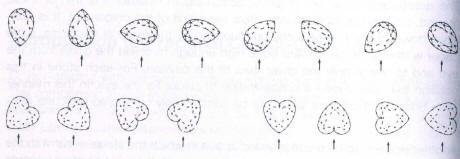- Varying color impression
- Comparing diamonds of different size
- Comparing diamonds of different hue
- Fluorescent diamonds
- Summary of instructions on practical color grading
color-grading with the aid of a daylight lamp is done in a folded white paper. The comparison stones in the series from colorless to yellow, previously cleaned, are laid in the channel of the fold, so that the tables lie on the flat and the culet upwards. The distance between the stones amounts to about 1 cm, it should never be less, because otherwise the color of one stone affects the neighboring one.
The folded paper is held between thumb and finger tips, at a distance of about 15 cm beneath the light source (Fig 3). The stones are, laid face down on the horizontal part of the grading. paper, which is folded at an angle of about 45°. The grader observes the brilliants perpendicularly to the pavilion facets and first takes a few moments to "familiarize" himself or herself with them before starting the grading.
After having already approximately estimated the color of the brilliant concerned, the grader now lays it - still with the table downwards - between the comparison stones and compares its color with the two adjacent brilliants.
There are two ways of clearly perceiving the color. The stone is observed not above the girdle, but perpendicularly to the pavilion facets about halfway up the pavilion towards the culet (Fig 3 a + 5).

Fig 3 a + b Position of brilliant in folded paper for color-grading
The quality and make of the girdle, according to whether "it is thin or thick, ground, polished or faceted, can affect the result of the color test. It is possible, however, to test the stone uninfluenced by the make of the girdle, if the paper is lifted with the forward edge high enough to shield the girdle from the eye and to reveal only the lower third of the pavilion. For each stone in 'this position the culet shows a concentration of color for the eye. In this manner even brilliants of different sizes can be satisfactorily compared with one another.
Another position to be recommended is one in which the stone is laid with the pavilion facets on the base bf the folded paper, with the culet pointing towards the observer (Fig 3 b).
The grader looks directly at the culet and sees the whole pavilion, without its being affected by the girdle. It is important to compare with one another only similar parts of the comparison stones and of those to be tested, e.g. both culets or both pavilions.
This particularly applies to stones of different sizes or brilliants with large inclusions in which only certain areas are free for comparison. Under the conditions described, moreover, the brilliance of the stone is restricted to a minimum and the reflections and strong surface luster - so distracting for color-grading are avoided.
In order to perceive the actual body color at its clearest, the stones should be breathed on. They then look completely "dull". The fine color nuances are most clearly seen when the stone begins to clear. Unfortunately too little use is made in practice of this simple method.
During color-grading one should slightly alter the position of the folded paper; reduce or increase the distance from the light-source and, by moving to and fro, alter the incidence of the light upon the stones. A slightly magnifying forehead lens or magnifying glass will sometimes remove doubt in color-grading.
With fancy cuts, too, - navettes, baguettes, pears, heart shapes or emerald cuts - one must concentrate on the point of the stone. In these cuts the color impact can differ in the longitudinal and transverse directions. In the longitudinal direction the color saturation- often looks stronger than in the transverse direction (Fig 4). Here, too, breathing on the stones is recommended in order to damp down the various brilliance effects. The lower color impression is decisive for the grader.

Fig 4 Fancy cuts should be observed in several directions
As already stated above, the environment in which the color-grading is carried out is of decisive importance. It should contain no bright colors - white, grey or black are best -, nor should it receive any direct daylight rays, e.g. through a large window. The ideal arrangement is a slightly darkened room. Before starting the color-grading, the comparison stones should be calmly observed one after the other for a few minutes, in order to "settle" the color differences and to accustom oneself to the altered lighting conditions.
color-grading should only be undertaken in a relaxed position and condition and the duration of grading should not be too long; it is better to work for short periods than to do so continuously for longer.
Despite all preparations there are every now and then borderline cases were doubt occurs as to the classification into a color-grade.
In such cases the doubtful
stone should be laid on another folded paper with its two adjacent
comparison brilliants, leaving slightly larger distances between them,
so as to avoid getting confused by the color of the other stones. It is
important to compare the doubtful stone both to the right and to the
left of each master stone, for it may give a different impression of
color on either side.
|
Comparison Brilliants as the Basis of color-Grading |
Varying color impression |